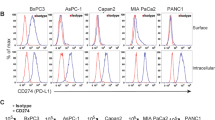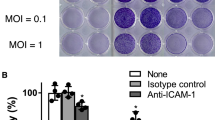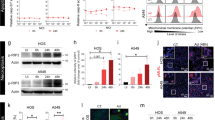Abstract
Newcastle disease virus (NDV) is a naturally occurring oncolytic virus with clinically proven efficacy against several human tumor types. Selective replication in and killing of tumor cells by NDV is thought to occur because of differences in innate immune responses between normal and tumor cells. In our effort to develop oncolytic virotherapy with NDV for patients with pancreatic cancer, we evaluated the responses to NDV infection and interferon (IFN) treatment of 11 different established human pancreatic adenocarcinoma cell lines (HPACs). Here we show that all HPACs were susceptible to NDV. However, this NDV infection resulted in different replication kinetics and cytotoxic effects. Better replication resulted in more cytotoxicity. No correlation was observed between defects in the IFN pathways and NDV replication or NDV-induced cytotoxicity. IFN production by HPACs after NDV infection differed substantially. Pretreatment of HPACs with IFN resulted in diminished NDV replication and decreased the cytotoxic effects in most HPACs. These findings suggest that not all HPACs have functional defects in the innate immune pathways, possibly resulting in resistance to oncolytic virus treatment. These data support the rationale for designing recombinant oncolytic NDVs with optimized virulence that should likely contain an antagonist of the IFN pathways.
This is a preview of subscription content, access via your institution
Access options
Subscribe to this journal
Receive 12 print issues and online access
$259.00 per year
only $21.58 per issue
Buy this article
- Purchase on Springer Link
- Instant access to full article PDF
Prices may be subject to local taxes which are calculated during checkout





Similar content being viewed by others
References
Ferlay J, Shin HR, Bray F, Forman D, Mathers C, Parkin DM . Estimates of worldwide burden of cancer in 2008: GLOBOCAN 2008. Int J Cancer 2010; 127: 2893–2917.
Neoptolemos JP, Stocken DD, Bassi C, Ghaneh P, Cunningham D, Goldstein D et al. Adjuvant chemotherapy with fluorouracil plus folinic acid vs gemcitabine following pancreatic cancer resection: a randomized controlled trial. JAMA 2010; 304: 1073–1081.
Sultana A, Smith CT, Cunningham D, Starling N, Neoptolemos JP, Ghaneh P . Meta-analyses of chemotherapy for locally advanced and metastatic pancreatic cancer. J Clin Oncol 2007; 25: 2607–2615.
Chiocca EA . Oncolytic viruses. Nat Rev Cancer 2002; 2: 938–950.
Bell J . Oncolytic viruses: an approved product on the horizon? Mol Ther 2010; 18: 233–234.
Zamarin D, Palese P . Oncolytic Newcastle disease virus for cancer therapy: old challenges and new directions. Future Microbiol 2012; 7: 347–367.
Sinkovics JG, Horvath JC . Newcastle disease virus (NDV): brief history of its oncolytic strains. J Clin Virol 2000; 16: 1–15.
Hotte SJ, Lorence RM, Hirte HW, Polawski SR, Bamat MK, O'Neil JD et al. An optimized clinical regimen for the oncolytic virus PV701. Clin Cancer Res 2007; 13: 977–985.
Reichard KW, Lorence RM, Cascino CJ, Peeples ME, Walter RJ, Fernando MB et al. Newcastle disease virus selectively kills human tumor cells. J Surg Res 1992; 52: 448–453.
Fiola C, Peeters B, Fournier P, Arnold A, Bucur M, Schirrmacher V . Tumor selective replication of Newcastle disease virus: association with defects of tumor cells in antiviral defence. Int J Cancer 2006; 119: 328–338.
Krishnamurthy S, Takimoto T, Scroggs RA, Portner A . Differentially regulated interferon response determines the outcome of Newcastle disease virus infection in normal and tumor cell lines. J Virol 2006; 80: 5145–5155.
Wilden H, Fournier P, Zawatzky R, Schirrmacher V . Expression of RIG-I, IRF3, IFN-beta and IRF7 determines resistance or susceptibility of cells to infection by Newcastle Disease Virus. Int J Oncol 2009; 34: 971–982.
Biswas M, Kumar SR, Allen A, Yong W, Nimmanapalli R, Samal SK et al. Cell-type-specific innate immune response to oncolytic newcastle disease virus. Viral Immunol 2012; 25: 268–276.
Vitale G, van Eijck CH, van Koetsveld Ing PM, Erdmann JI, Speel EJ, van der Wansem Ing K et al. Type I interferons in the treatment of pancreatic cancer: mechanisms of action and role of related receptors. Ann Surg 2007; 246: 259–268.
Cassel WA, Murray DR . A ten-year follow-up on stage II malignant melanoma patients treated postsurgically with Newcastle disease virus oncolysate. Med Oncol Tumor Pharmacother 1992; 9: 169–171.
Freeman AI, Zakay-Rones Z, Gomori JM, Linetsky E, Rasooly L, Greenbaum E et al. Phase I/II trial of intravenous NDV-HUJ oncolytic virus in recurrent glioblastoma multiforme. Mol Ther 2006; 13: 221–228.
Vigil A, Park MS, Martinez O, Chua MA, Xiao S, Cros JF et al. Use of reverse genetics to enhance the oncolytic properties of Newcastle disease virus. Cancer Res 2007; 67: 8285–8292.
Zamarin D, Martinez-Sobrido L, Kelly K, Mansour M, Sheng G, Vigil A et al. Enhancement of oncolytic properties of recombinant newcastle disease virus through antagonism of cellular innate immune responses. Mol Ther 2009; 17: 697–706.
Elankumaran S, Chavan V, Qiao D, Shobana R, Moorkanat G, Biswas M et al. Type I interferon-sensitive recombinant newcastle disease virus for oncolytic virotherapy. J Virol 2010; 84: 3835–3844.
Janke M, Peeters B, de Leeuw O, Moorman R, Arnold A, Fournier P et al. Recombinant Newcastle disease virus (NDV) with inserted gene coding for GM-CSF as a new vector for cancer immunogene therapy. Gene Ther 2007; 14: 1639–1649.
Janke M, Peeters B, Zhao H, de Leeuw O, Moorman R, Arnold A et al. Activation of human T cells by a tumor vaccine infected with recombinant Newcastle disease virus producing IL-2. Int J Oncol 2008; 33: 823–832.
Zamarin D, Vigil A, Kelly K, Garcia-Sastre A, Fong Y . Genetically engineered Newcastle disease virus for malignant melanoma therapy. Gene Ther 2009; 16: 796–804.
Zhao H, Janke M, Fournier P, Schirrmacher V . Recombinant Newcastle disease virus expressing human interleukin-2 serves as a potential candidate for tumor therapy. Virus Res 2008; 136: 75–80.
Masters JR, Thomson JA, Daly-Burns B, Reid YA, Dirks WG, Packer P et al. Short tandem repeat profiling provides an international reference standard for human cell lines. Proc Natl Acad Sci USA 2001; 98: 8012–8017.
Kuiken T, van den Hoogen BG, van Riel DA, Laman JD, van Amerongen G, Sprong L et al. Experimental human metapneumovirus infection of cynomolgus macaques (Macaca fascicularis) results in virus replication in ciliated epithelial cells and pneumocytes with associated lesions throughout the respiratory tract. Am J Pathol 2004; 164: 1893–1900.
Reed LJ, Muench H . A simple method of estimating fifty per cent endpoints. Am J Hyg 1938; 27: 493–497.
Jordan M, Schallhorn A, Wurm FM . Transfecting mammalian cells: optimization of critical parameters affecting calcium-phosphate precipitate formation. Nucleic Acids Res 1996; 24: 596–601.
Livak KJ, Schmittgen TD . Analysis of relative gene expression data using real-time quantitative PCR and the 2(-Delta Delta C(T)) Method. Methods 2001; 25: 402–408.
Pecora AL, Rizvi N, Cohen GI, Meropol NJ, Sterman D, Marshall JL et al. Phase I trial of intravenous administration of PV701, an oncolytic virus, in patients with advanced solid cancers. J Clin Oncol 2002; 20: 2251–2266.
Wei D, Sun N, Nan G, Wang Y, Liu HQ, Peeters B et al. Construction of recombinant Newcastle disease virus Italien strain for oncolytic virotherapy of tumors. Hum Gene Ther 2012; 23: 700–710.
Kumar R, Tiwari AK, Chaturvedi U, Kumar GR, Sahoo AP, Rajmani RS et al. Velogenic Newcastle disease virus as an oncolytic virotherapeutics: in vitro characterization. Appl Biochem Biotechnol 2012; 167: 2005–2022.
Cassel WA, Garrett RE . Newcastle disease virus as an antineoplastic agent. Cancer 1965; 18: 863–868.
Mansour M, Palese P, Zamarin D . Oncolytic specificity of Newcastle disease virus is mediated by selectivity for apoptosis-resistant cells. J Virol 2011; 85: 6015–6023.
Walter RJ, Attar BM, Rafiq A, Tejaswi S, Delimata M . Newcastle disease virus LaSota strain kills human pancreatic cancer cells in vitro with high selectivity. JOP 2012; 13: 45–53.
Walter RJ, Attar BM, Rafiq A, Delimata M, Tejaswi S . Two avirulent, lentogenic strains of Newcastle disease virus are cytotoxic for some human pancreatic tumor lines in vitro. JOP 2012; 13: 502–513.
Miszczuk-Jamska B, Merten M, Guy-Crotte O, Amouric M, Clemente F, Schoumacher RA et al. Characterization of trypsinogens 1 and 2 in two human pancreatic adenocarcinoma cell lines; CFPAC-1 and CAPAN-1. FEBS Lett 1991; 294: 175–178.
Ohta T, Terada T, Nagakawa T, Tajima H, Itoh H, Fonseca L et al. Pancreatic trypsinogen and cathepsin B in human pancreatic carcinomas and associated metastatic lesions. Br J Cancer 1994; 69: 152–156.
Puhlmann J, Puehler F, Mumberg D, Boukamp P, Beier R . Rac1 is required for oncolytic NDV replication in human cancer cells and establishes a link between tumorigenesis and sensitivity to oncolytic virus. Oncogene 2010; 29: 2205–2216.
Lazar I, Yaacov B, Shiloach T, Eliahoo E, Kadouri L, Lotem M et al. The oncolytic activity of Newcastle disease virus NDV-HUJ on chemoresistant primary melanoma cells is dependent on the proapoptotic activity of the inhibitor of apoptosis protein Livin. J Virol 2010; 84: 639–646.
Murphy AM, Besmer DM, Moerdyk-Schauwecker M, Moestl N, Ornelles DA, Mukherjee P et al. Vesicular stomatitis virus as an oncolytic agent against pancreatic ductal adenocarcinoma. J Virol 2012; 86: 3073–3087.
Morak MJ, van Koetsveld PM, Kanaar R, Hofland LJ, van Eijck CH . Type I interferons as radiosensitisers for pancreatic cancer. Eur J Cancer 2011; 47: 1938–1945.
Jost E, Roos WP, Kaina B, Schmidberger H . Response of pancreatic cancer cells treated with interferon-alpha or beta and co-exposed to ionising radiation. Int J Radiat Biol 2010; 86: 732–741.
Tomimaru Y, Eguchi H, Wada H, Tomokuni A, Kobayashi S, Marubashi S et al. Synergistic antitumor effect of interferon-ss with gemcitabine in interferon-alpha-non-responsive pancreatic cancer cells. Int J Oncol 2011; 38: 1237–1243.
Levy DE, Garcia-Sastre A . The virus battles: IFN induction of the antiviral state and mechanisms of viral evasion. Cytokine Growth Factor Rev 2001; 12: 143–156.
Acknowledgements
This study was supported by the Virgo consortium, funded by the Dutch government project number FES0908 and by the Netherlands Genomics Initiative (NGI) project number 050-060-452.
Author information
Authors and Affiliations
Corresponding author
Ethics declarations
Competing interests
The authors declare no conflict of interest.
Rights and permissions
About this article
Cite this article
Buijs, P., van Eijck, C., Hofland, L. et al. Different responses of human pancreatic adenocarcinoma cell lines to oncolytic Newcastle disease virus infection. Cancer Gene Ther 21, 24–30 (2014). https://doi.org/10.1038/cgt.2013.78
Received:
Revised:
Accepted:
Published:
Issue Date:
DOI: https://doi.org/10.1038/cgt.2013.78



